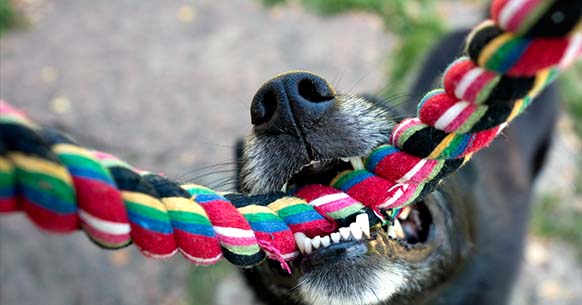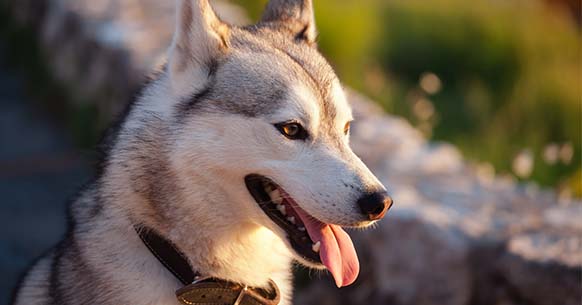How To Motivate Your Dog To Do Anything You Want…
When I was a child, I remember going to a friend’s house, and his family had this incredible Border Collie as their family dog. This dog had so much energy, he always wanted to play and absolutely loved to play fetch. To me, this was the coolest thing I had ever seen!
One impressing thing that I remember, was my friend biking to the park and having his dog run behind him, without even needing to use a leash. Then they had lots of fun while playing fetch together for what seemed like an eternity.
This short yet very inspirational experience left me in “awe” and I desperately wanted a dog. But it wouldn’t be until 15 years later that I got my first Border Collie… I named her Chase because I wanted her to chase balls.
Once I brought Chase home as a puppy, I immediately noticed that she was extremely timid and scared of everything. I had to constantly reassure her that everything was going to be okay and that she was in good hands.
But one thing that I promised myself at the time, was that I would do everything possible to help Chase associate massive pleasure with toys.I did many different exercises with her, and today she absolutely loves toys … even more than treats!
So in this short e-mail, I will talk about the ways with which I accomplished this, so that you can have the same kind of success with your dog.
I think the most important thing that I did, was to make a BIG deal whenever Chase played with any of her toys. I literally cheered like I had won the lottery or been selected on the “Price is Right” whenever she started playing with her Kong, tennis ball or stuffed animal.
She quickly realized that playing with toys got her lots of attention from me, and so the behavior of playing with the toys grew and became a way of life for her.
Then… I made playing with the toys even more exciting! I triggered her chasing instincts by moving the toys on the floor so that she had to run after it to get it. I remember one time tying a rope to one of her plush toy and dragging it across the room for her to chase – it was so much fun!
But the key to this exercise … is that I never let her decide when the game was over. I would always end the game while my dog was highly engaged in playing with me. So that I knew next time we played together, she would put even more energy into it.
I would always end the game by saying “That’s it!” .. and run outside to changer her state of mind. This way she associated me taking the toy away as something positive and fun … going outside with dad!
Well, now it’s your turn! I guarantee that if you practice this simple exercise for a week that you will see a difference in your dog’s enthusiasm with playing with toys. Give it a try … It’ll only take 5 minutes!
Power Quote: “The quality of the relationship with your dog depends on the time and energy that you put into it.” – Jean Cote
Why Punishing My Dog Didn’t Work…
When I first started learning about dog training, I was totally overwhelmed by the vast amount of information available. It was so confusing, even the top dog trainers in the world disagreed with each other on which training method was better.
You’d have Caesar Millan on one hand who advocates the dominance theory, and then you’d also have the exact opposite with Karen Pryor who trains strictly with Positive Reinforcements…
So… Which one is right? And who should I listen to when training my dog?!
To be totally honest with you, I was confused. So I decided to go to my local dog training school and do what they told me. Their training methods were a mixture between the two; they would punish the dog for bad behaviors and reward the dog for good behaviors.
On the surface, this system seemed to work very well – my dogs were obedient. But one day, something strange happened…
I was at a local agility ring, and my dog Onyx (a Siberian Husky) was pulling on the leash very hard, as she wanted to go play with another dog. So I did as I had been told, and I yanked on the leash to correct my dog for the bad behavior. But I could tell that the yanking really hurt my dog, she was moving her tongue as if the yanking on the leash made her bite it.
And to make it worse, other people there were all staring at me like I did something wrong. So I began to question myself… “Did I do the right thing?”
I kept convincing myself that this was the proper response, because that’s what the trainers had told me to do when she pulled on the leash. But was it? Was there an alternative?
My world changed when I asked myself this question: “If I were a dog, how would I like to be trained?”
And my answer was eye-opening! Because I wouldn’t want to be trained with corrections like I was doing.
So I made the decision to learn how the experts in positive reinforcements training were able to train their dogs. And what I discovered was that you really don’t need to correct your dog, you simply need to build the good behaviors strongly enough that it becomes second nature to the dog.
And that’s what I’ve been doing ever since. So it is my hope with this e-mail that you will learn from my mistakes, and also learn a new way of training your dog … because in the end, I think what we really want as dog owners is to have a dog that is happy and behaves nicely. We can have both!
Power Quote: “Positive reinforcement training is in my opinion, the best way to build trust in the relationship with your dog.” – Jean Cote


